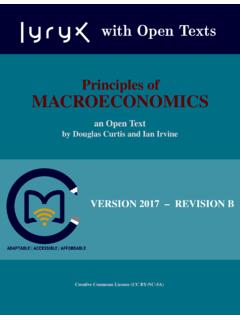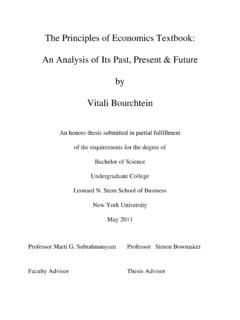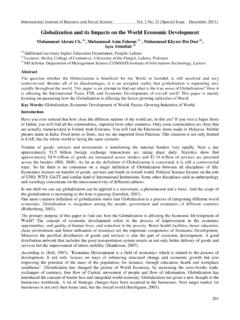Transcription of Principles of Microeconomics - Lyryx Learning
1 With Open TextsPrinciples ofMICROECONOMICSan Open Textby Douglas Curtis and Ian IrvineVERSION 2017 REVISION BADAPTABLE | ACCESSIBLE | AFFORDABLEC reative Commons License (CC BY-NC-SA)advancing learningChampions of Access to KnowledgeOPEN TEXTONLINEASSESSMENTAll digital forms of access to our high-quality open texts are entirely FREE! Allcontent is reviewed for excellence and iswholly adaptable; custom editions are pro-duced by Lyryx for those adopting Lyryx as-sessment. Access to the original source filesis also open to anyone!We have been developing superior on-line formative assessment for more than15 years. Our questions are continuouslyadapted with the content and reviewed forquality and sound pedagogy. To enhancelearning, students receive immediate per-sonalized feedback. Student grade reportsand performance statistics are also to our in-house support team is avail-able 7 days/week to provide prompt resolu-tion to both student and instructor addition, we work one-on-one with in-structors to provide a comprehensive sys-tem, customized for their course.
2 This caninclude adapting the text, managing multi-ple sections, and more!Additional instructor resources are alsofreely accessible. Product dependent, thesesupplements include: full sets of adaptableslides and lecture notes, solutions manuals,and multiple choice question banks with anexam building Lyryx learningPrinciples of Microeconomicsan Open Text by Douglas Curtis and Ian IrvineVersion 2017 Revision BBE A CHAMPION OF OER!Contribute suggestions for improvements, new content, or errata:A new topicA new exampleAn interesting new questionAny other suggestions to improve the materialContact Lyryx your Learning TeamBruce BauslaughPeter ChowNathan FriessStephanie KeyowskiClaude LaflammeMartha LaflammeJennifer MacKenzieTamsyn MurnaghanBogdan SavaRyan YeeLICENSEC reative Commons License (CC BY-NC-SA): This text, including the art and illustrations, areavailable under the Creative Commons license (CC BY-NC-SA), allowing anyone to reuse, revise,remix and redistribute the view a copy of this license, learningPrinciples of Microeconomicsan Open Text by Douglas Curtis and Ian IrvineBase Text Revision HistoryCurrent Revision.
3 Version 2017 RevisionBEdits and revisions have been completed by the authors together with the editorial staff at Lyryx new content (text and images) is released under the same license as noted B Data, tables, and figures have been updated to the latest available data. Applications and discus-sions have been edited to discuss and comment on these current observations. New content added including zero-sum games, teams and services, market design and matching,and returns to scale for the production of intermediate goods. Discussion of climate change in relation to externalitiesis expanded and updated to reflect A Front matter has been updated including cover, copyright,and revision of ContentsTable of ContentsiiiAbout the Authors1 Part One: The Building Blocks31 Introduction to key What s it all about?.. Understanding through the use of models.. Opportunity cost and the market.. A model of exchange and specialization.. Economy-wide production possibilities.
4 Aggregate output, growth and business cycles.. 17 Conclusion.. 22 Key Terms.. 23 Exercises for Chapter 1.. 242 Theories, data and Data analysis.. 27iiiivTable of Data, theory and economic models.. Ethics, efficiency and beliefs.. 36 Key Terms.. 40 Exercises for Chapter 2.. 413 The classical marketplace demand and The marketplace trading.. The market s building blocks.. Demand and supply curves.. Non-price influences on demand.. Non-price influences on supply.. Simultaneous supply and demand impacts.. Market interventions governments and interest groups.. Individual and market functions.. Useful techniques demand and supply equations.. 63 Conclusion.. 64 Key Terms.. 65 Exercises for Chapter 3.. 67 Part Two: Responsiveness and the Value of Markets714 Measures of response: Price responsiveness of demand.. Price elasticities and public policy.. 79 Table of The time horizon and inflation.. Cross-price elasticities cable or satellite.
5 The income elasticity of demand.. Elasticity of supply.. Elasticities and tax incidence.. Technical tricks with elasticities.. 90 Key Terms.. 91 Exercises for Chapter 4.. 925 Welfare economics and Equity and efficiency.. Consumer and producer surplus.. Efficient market outcomes.. Taxation, surplus and efficiency.. Market failures externalities.. Other market failures.. Environmental policy and climate change.. 110 Conclusion.. 117 Key Terms.. 118 Exercises for Chapter 5.. 120 Part Three: Decision Making by Consumer and Producers1236 Individual choice125viTable of Rationality.. Choice with measurable utility.. Choice with ordinal utility.. Applications of indifference analysis.. 142 Key Terms.. 147 Exercises for Chapter 6.. 1487 Firms, investors and capital Business organization.. Profit.. Risk and the investor.. Risk pooling and diversification.. 158 Conclusion.. 161 Key Terms.. 162 Exercises for Chapter 7.
6 1648 Production and Efficient production.. The time frame.. Production in the short run.. Costs in the short run.. Fixed costs and sunk costs.. Long-run production and costs.. Technological change and globalization.. 184 Table of Clusters, Learning by doing, scope economies.. 186 Conclusion.. 187 Key Terms.. 188 Exercises for Chapter 8.. 190 Part Four: Market Structures1939 Perfect The perfect competition paradigm.. Market characteristics.. The firm s supply decision.. Dynamics: Entry and exit.. Long-run industry supply.. Globalization and technological change.. Efficient resource allocation.. 211 Key Terms.. 212 Exercises for Chapter 9.. 21310 Monopolies.. Profit maximizing behaviour.. Long-run choices.. Output inefficiency.. Price discrimination.. 230viiiTable of Cartels: Acting like a monopolist.. Invention, innovation and rent seeking.. 238 Conclusion.. 240 Key Terms.. 241 Exercises for Chapter 10.. 24211 Imperfect Imperfect competitors.
7 Performance-based measures of structure market power.. Monopolistic competition.. Oligopoly and games.. Duopoly and Cournot games.. Entry, exit & potential competition.. Market design and Matching.. 260 Conclusion.. 262 Key Terms.. 263 Exercises for Chapter 11.. 265 Part Five: The Factors of Production26912 Labour and Labour a derived demand.. The supply of labour.. Labour market equilibrium and mobility.. 279 Table of Capital concepts.. The capital market.. Land.. 289 Key Terms.. 291 Exercises for Chapter 12.. 29313 Human capital and the income Human capital.. Productivity and education.. On-the-job training.. Education as signalling.. Education returns and quality.. Discrimination.. The income distribution.. Wealth and capitalism.. 309 Key Terms.. 312 Exercises for Chapter 13.. 313 Part Six: Government and Trade31714 Market failure.. Fiscal federalism: Taxing and spending.. Federal-provincial fiscal relations.. 326xTable of Government-to-individual transfers.
8 Regulation and competition policy.. 332 Key Terms.. 338 Exercises for Chapter 14.. 33915 International Trade in our daily lives.. Canada in the world economy.. The gains from trade: Comparative advantage.. Returns to scale and dynamic gains from trade.. Trade barriers: Tariffs, subsidies and quotas.. The politics of protection.. Institutions governing trade.. 360 Key Terms.. 362 Exercises for Chapter 15.. 363 Glossary367 Solutions To Exercises383 Chapter 1 Solutions383 Chapter 2 Solutions385 Chapter 3 Solutions388 Table of ContentsxiChapter 4 Solutions393 Chapter 5 Solutions398 Chapter 6 Solutions401 Chapter 7 Solutions406 Chapter 8 Solutions408 Chapter 9 Solutions412 Chapter 10 Solutions416 Chapter 11 Solutions421 Chapter 12 Solutions423 Chapter 13 Solutions425 Chapter 14 Solutions428 Chapter 15 Solutions430 About the AuthorsDoug Curtisis a specialist in macroeconomics . He is the author of numerous research papers onfiscal policy, monetary policy, and economic growth and structural change.
9 He has also preparedresearch reports for Canadian industry and government agencies and authored numerous workingpapers. He completed his PhD at McGill University, and has held visiting appointments at theUniversity of Cambridge and the University of York in the United Kingdom. His current researchinterests are monetary and fiscal policy rules, and the relationship between economic growth andstructural change. He is Professor Emeritus of Economics atTrent University in Peterborough,Ontario, and also held an appointment as Sessional Adjunct Professor in the Department of Eco-nomics at Queen s University in Kingston, Ontario from 2003until Irvineis a specialist in Microeconomics , public economics, economic inequality and healtheconomics. He is the author of numerous research papers in these fields. He completed his PhDat the University of Western Ontario, has been a visitor at the London School of Economics, theUniversity of Sydney, the University of Colorado, University College Dublin and the Economicand Social Research Institute.
10 His current research interests are in tobacco use and taxation, andCanada s Employment Insurance and Welfare systems. He has done numerous studies for theGovernment of Canada, and is currently a Professor of Economics at Concordia University PhilosophyPrinciples of Microeconomicsfocuses upon the material that students need to cover in a first intro-ductory course. It is slightly more compact than the majority of Principles books in the Canadianmarketplace. Decades of teaching experience and textbook writing has led the authors to avoid theencyclopedic approach that characterizes the recent trends in with this approach, there are no appendices or afterthought chapters. No materialis relegated elsewhere for a limited audience; the text makes choices on what issues and topicsare important in an introductory course. This philosophy has resulted in a Micro book of just 15chapters, of which Chapters1through3are common to both Micro and Macro, and a Macro bookof 13 are domestic and international in their subject matter and are of the modern era con-sumers buy iPods, snowboards and jazz, not so much coffee andhamburgers.









